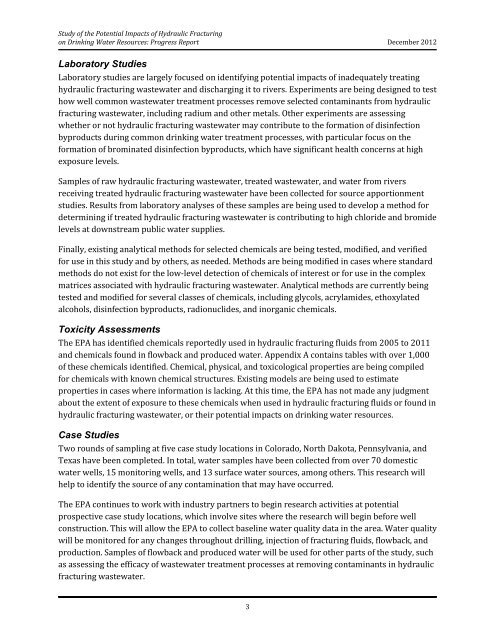hf-report20121214
hf-report20121214
hf-report20121214
Create successful ePaper yourself
Turn your PDF publications into a flip-book with our unique Google optimized e-Paper software.
Study of the Potential Impacts of Hydraulic Fracturing<br />
on Drinking Water Resources: Progress Report December 2012<br />
Laboratory Studies<br />
Laboratory studies are largely focused on identifying potential impacts of inadequately treating<br />
hydraulic fracturing wastewater and discharging it to rivers. Experiments are being designed to test<br />
how well common wastewater treatment processes remove selected contaminants from hydraulic<br />
fracturing wastewater, including radium and other metals. Other experiments are assessing<br />
whether or not hydraulic fracturing wastewater may contribute to the formation of disinfection<br />
byproducts during common drinking water treatment processes, with particular focus on the<br />
formation of brominated disinfection byproducts, which have significant health concerns at high<br />
exposure levels.<br />
Samples of raw hydraulic fracturing wastewater, treated wastewater, and water from rivers<br />
receiving treated hydraulic fracturing wastewater have been collected for source apportionment<br />
studies. Results from laboratory analyses of these samples are being used to develop a method for<br />
determining if treated hydraulic fracturing wastewater is contributing to high chloride and bromide<br />
levels at downstream public water supplies.<br />
Finally, existing analytical methods for selected chemicals are being tested, modified, and verified<br />
for use in this study and by others, as needed. Methods are being modified in cases where standard<br />
methods do not exist for the low-level detection of chemicals of interest or for use in the complex<br />
matrices associated with hydraulic fracturing wastewater. Analytical methods are currently being<br />
tested and modified for several classes of chemicals, including glycols, acrylamides, ethoxylated<br />
alcohols, disinfection byproducts, radionuclides, and inorganic chemicals.<br />
Toxicity Assessments<br />
The EPA has identified chemicals reportedly used in hydraulic fracturing fluids from 2005 to 2011<br />
and chemicals found in flowback and produced water. Appendix A contains tables with over 1,000<br />
of these chemicals identified. Chemical, physical, and toxicological properties are being compiled<br />
for chemicals with known chemical structures. Existing models are being used to estimate<br />
properties in cases where information is lacking. At this time, the EPA has not made any judgment<br />
about the extent of exposure to these chemicals when used in hydraulic fracturing fluids or found in<br />
hydraulic fracturing wastewater, or their potential impacts on drinking water resources.<br />
Case Studies<br />
Two rounds of sampling at five case study locations in Colorado, North Dakota, Pennsylvania, and<br />
Texas have been completed. In total, water samples have been collected from over 70 domestic<br />
water wells, 15 monitoring wells, and 13 surface water sources, among others. This research will<br />
help to identify the source of any contamination that may have occurred.<br />
The EPA continues to work with industry partners to begin research activities at potential<br />
prospective case study locations, which involve sites where the research will begin before well<br />
construction. This will allow the EPA to collect baseline water quality data in the area. Water quality<br />
will be monitored for any changes throughout drilling, injection of fracturing fluids, flowback, and<br />
production. Samples of flowback and produced water will be used for other parts of the study, such<br />
as assessing the efficacy of wastewater treatment processes at removing contaminants in hydraulic<br />
fracturing wastewater.<br />
3


